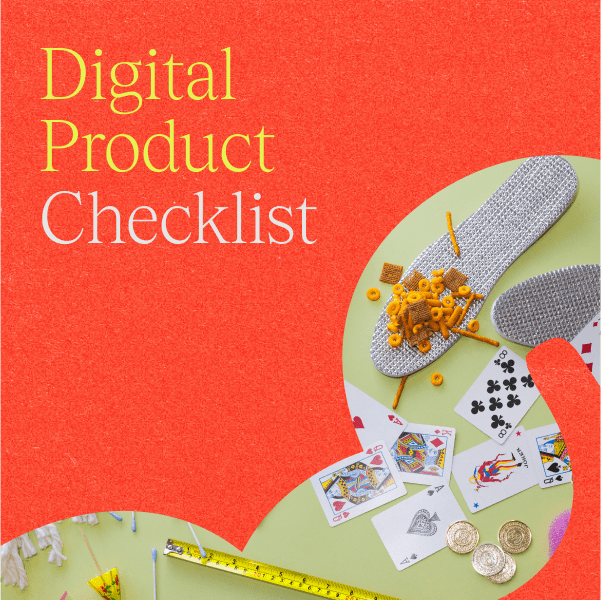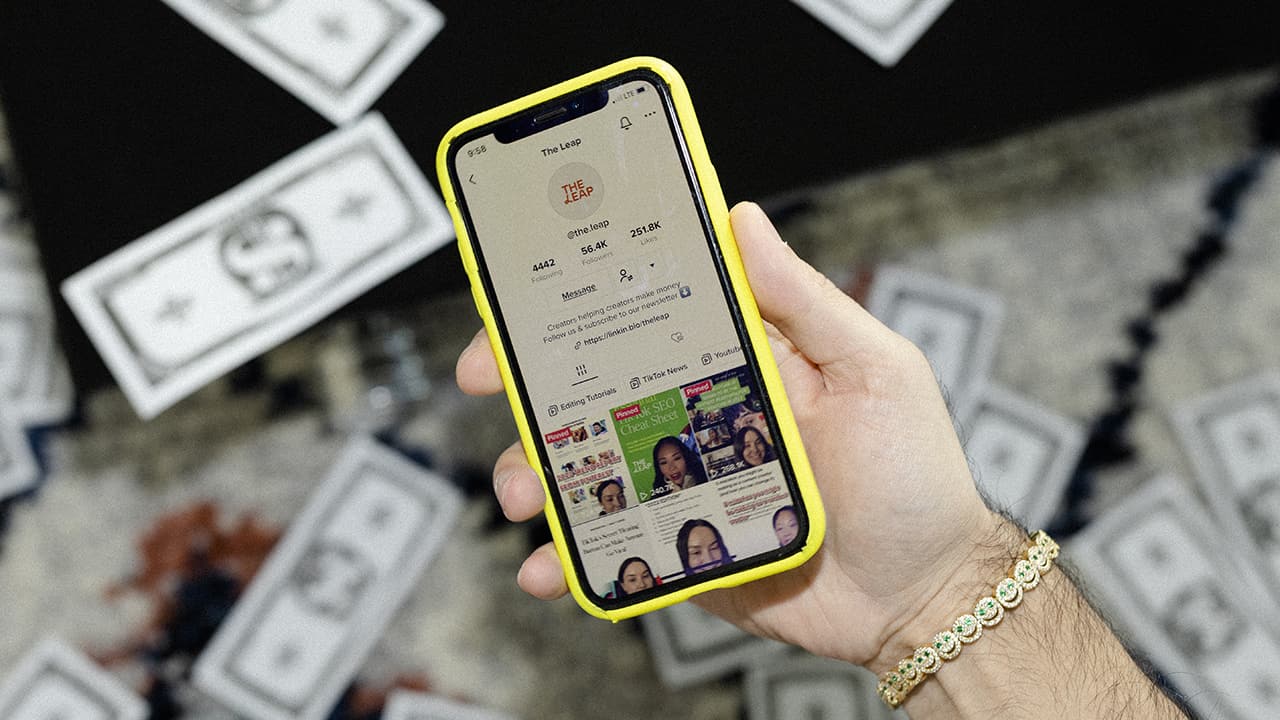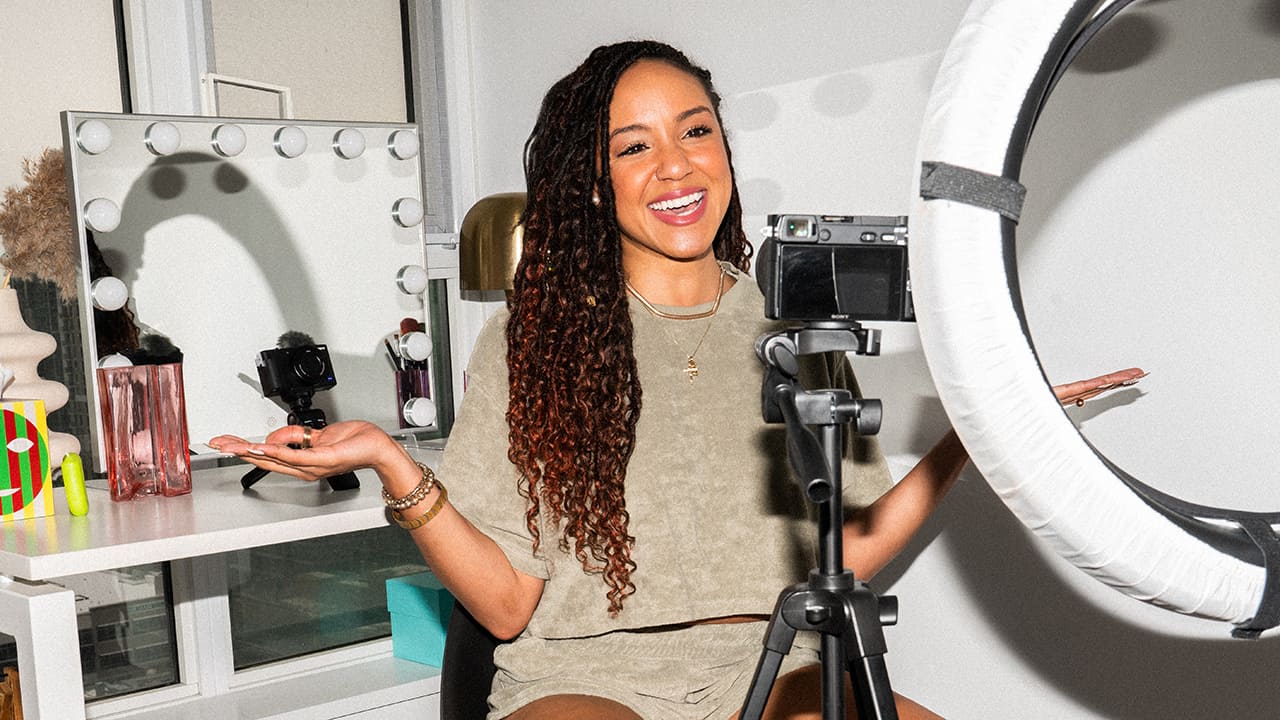If you’re already using Patreon, you’d know that the membership platform has long been a game-changer for creators. Getting direct financial support from your audience instead of relying on inconsistent brand deals and partner programs can be the bedrock for a successful content creation career or side hustle. Even better, Patreon is now offering more than just the ability to sell memberships to your most dedicated followers — you can sell digital products on the platform to bring in more money.
Interested in learning how to sell digital products on Patreon? Here’s everything you need to know.
What is Patreon?
Patreon is a membership platform created for content creators who want to diversify their income while building a closer relationship with their audience. Creators can give their paid subscribers (or patrons) exclusive access to content, communities like Discord servers, or even digital meet-ups. While Patreon offers both free and paid memberships, most creators set up multiple paid membership tiers, meaning that Patreon is a great source of recurring income.
In June 2023, Patreon also started offering creators the ability to sell digital products directly through the platform. That means creators with a sizeable Patreon following can now offer their digital products in the same place, rather than sending their patrons to a separate e-commerce website like Gumroad.

What digital products can you sell on Patreon?
As far as hard guidelines go, Patreon only has a few restrictions on what you can sell:
- The digital products you sell need to be appropriate for all ages. That means they can’t feature any nudity or sexually explicit content.
- Your digital products also need to abide by Patreon’s Community Guidelines, which means anything that falls under the umbrella of hate speech and graphic violence (with exceptions like documentaries and fiction) won’t be permitted.
Once you’ve checked those boxes, you just need to make sure your digital product is actually supported by the platform, meaning that it’s the right file type and doesn’t run afoul of certain limitations.
You can sell images, videos, audio files, ebooks, and more. For example, a podcaster may sell complete, never-before-heard episodes. A YouTuber may sell a video tutorial on building the perfect recording setup. Similarly, an author may sell short stories, and so on.
Digital product ideas to sell on Patreon
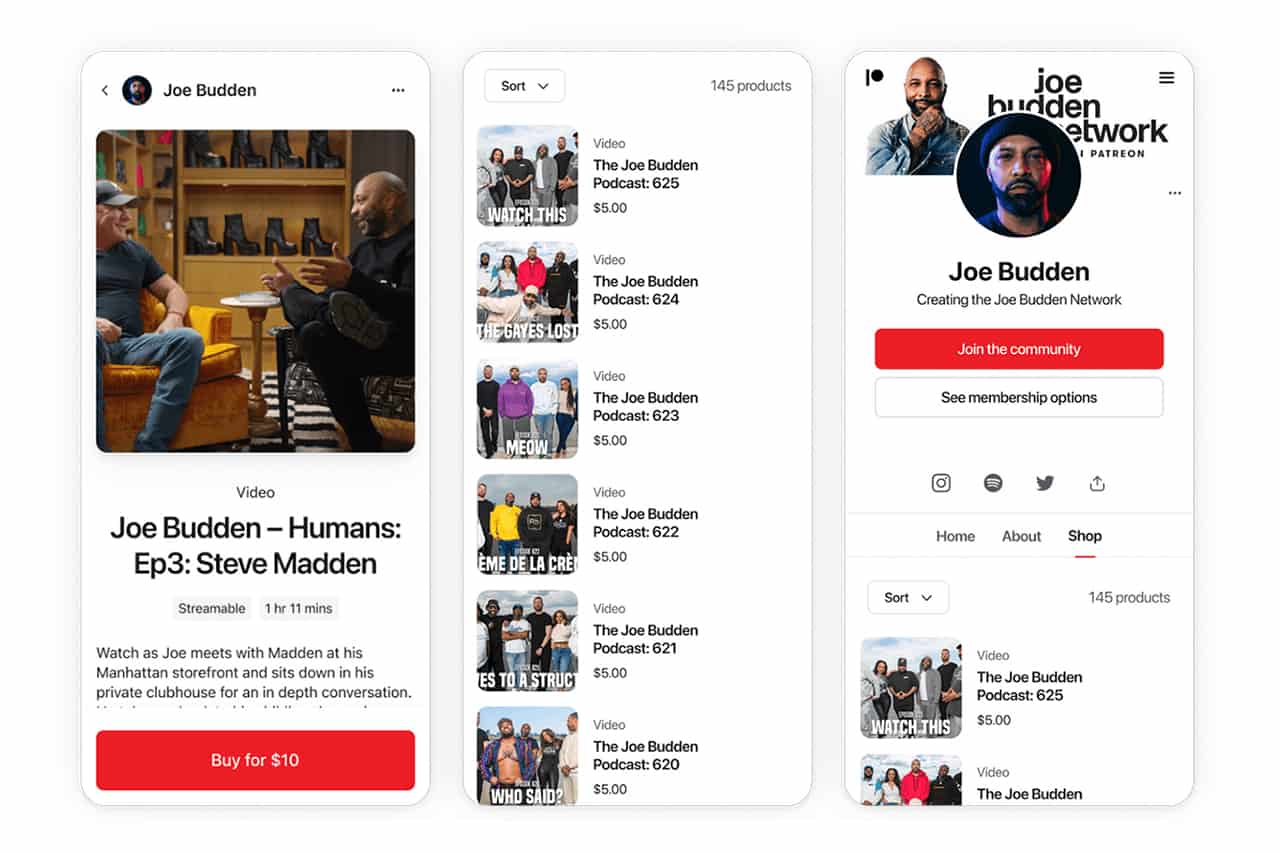
No matter what kind of creator you are, you can sell digital products on Patreon. Digital products take less effort to create and send to buyers than merch or other physical products. What’s more, they are a great way to diversify your income. Here are some ideas to consider:
- Ebooks: From writing an e-cookbook to dreaming up your own digital comic, creating an ebook certainly requires thoughtful planning and execution. However, selling it through Patreon makes the publishing process as simple as tapping a few buttons.
- Templates: No matter what your niche is, you’re probably using some kind of software to make your day-to-day easier, and someone out there will benefit from you sharing exactly how you do that. Whether it’s a content strategy template in a Word document or a productivity template on Notion, templates can be immensely profitable.
- Digital prints: Artists, cartoonists, and other creators with skills in the visual arts can offer downloadable, printable copies of their artwork through Patreon.
- One-off vlogs: Vlogging a special occasion? You can absolutely charge your audience for viewing the content. Think a behind-the-scenes look at an exclusive event, or once-in-a-lifetime experiences like sailing in the Komodo Islands.
- Individual tutorials: While Patreon isn’t set up for selling online courses, you can sell standalone tutorials on the platform. For example, artists can teach the esoteric art of drawing hands, financial creators can share their tips for retirement planning, and fitness influencers can offer exclusive workout routines.
Examples of creators selling digital products on Patreon
Looking for more inspiration? Here are a few examples of creators who are already selling digital products on Patreon.
- Achewood, a cartoonist who publishes a weekly comic on Patreon, uses the platform to sell digital zines, cookbooks, and more.
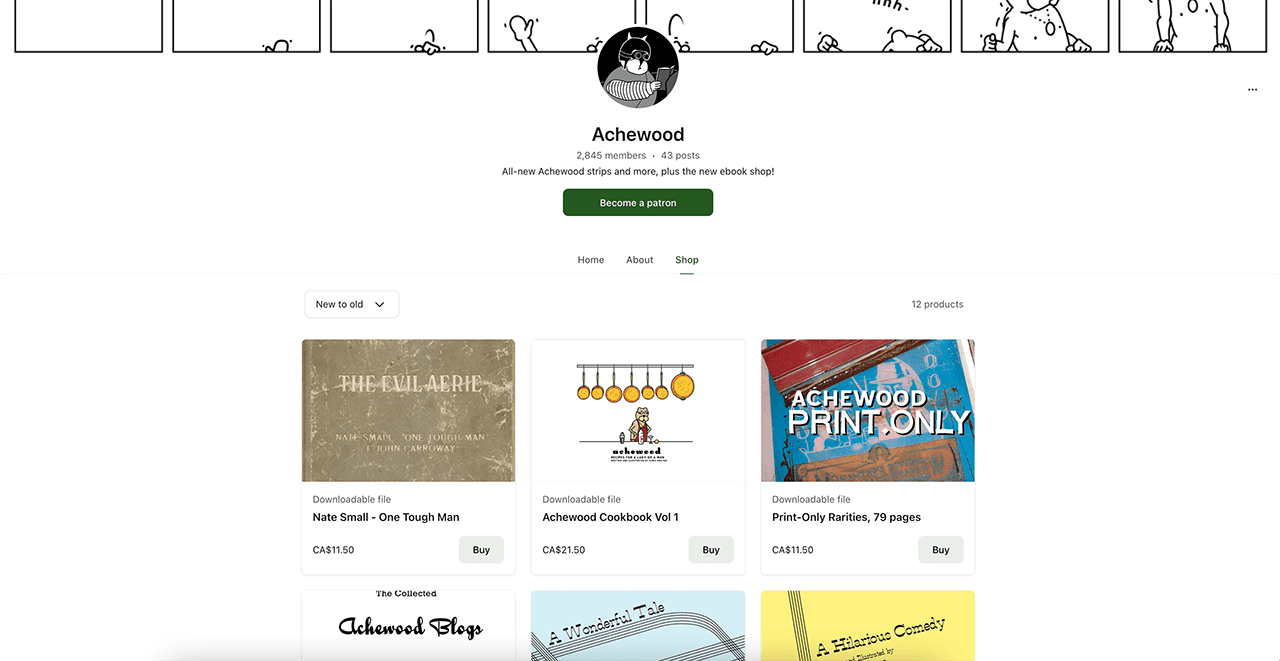
- Archvillain Games, a studio that creates 3D-printable miniature models, sells downloadable 3D models of those miniatures directly through Patreon, as well as ebooks.
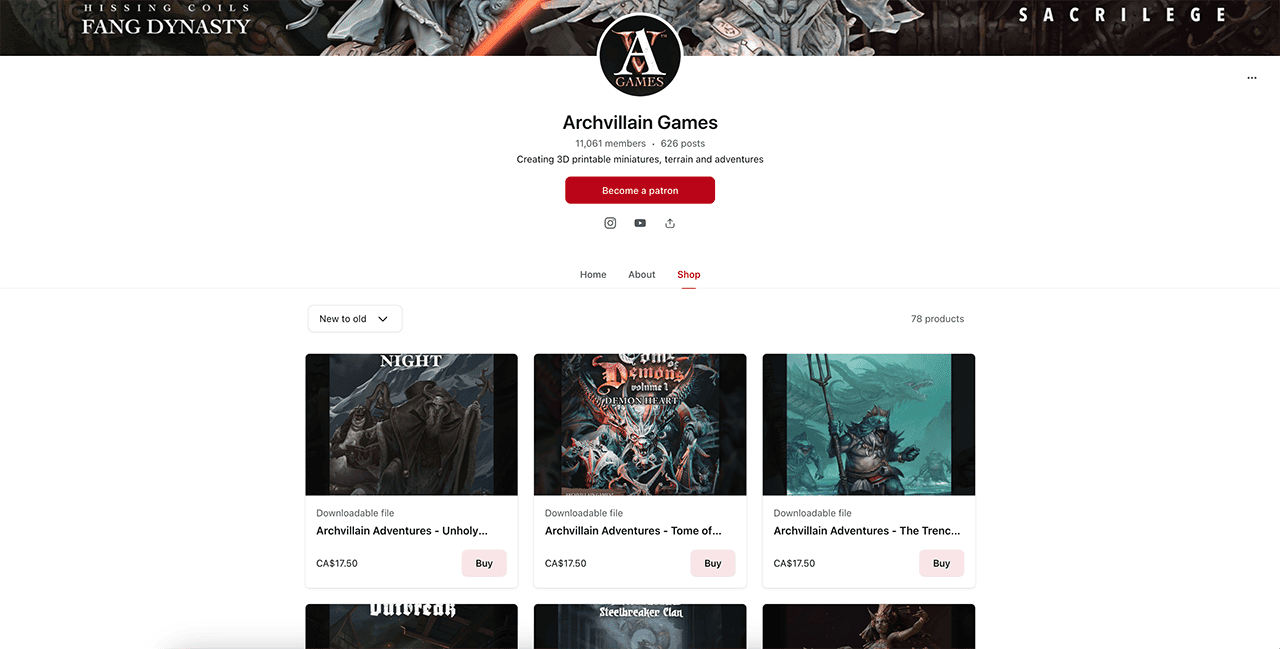
- Chapo Trap House, a satirical political podcast that shares exclusive podcast episodes on Patreon, sells mini-collections of their best archival episodes.
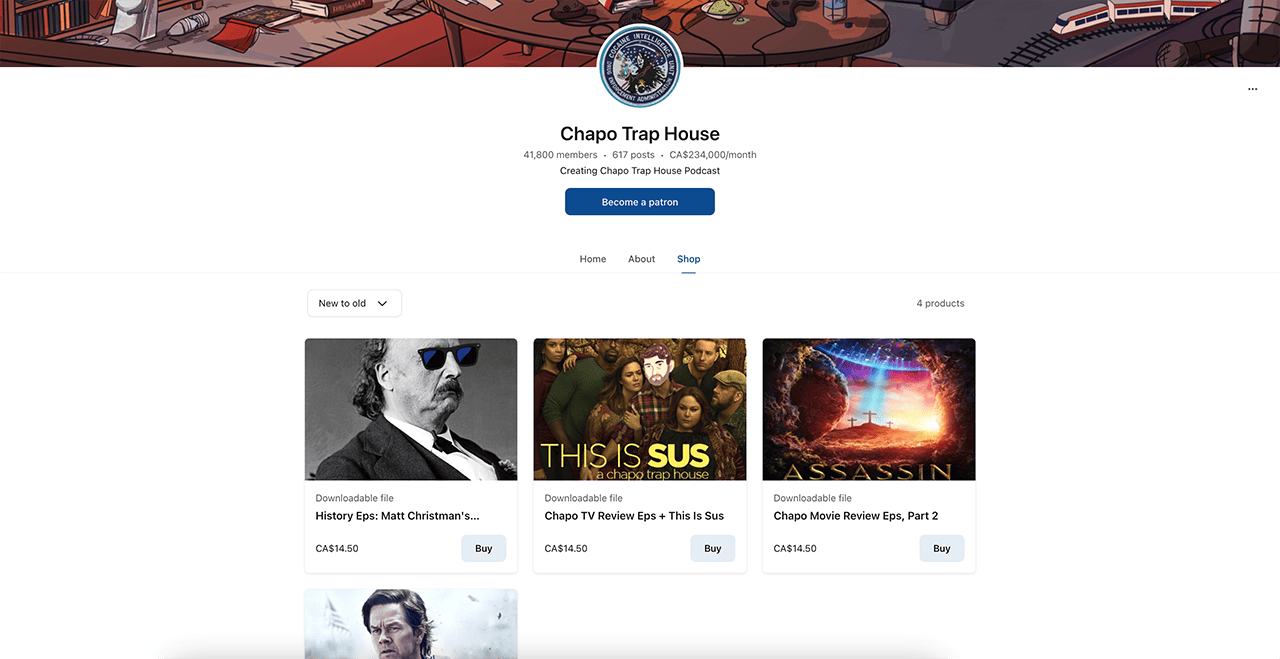
Who can buy my digital products on Patreon?
Anyone can purchase your digital products on Patreon. While it might be easier to get your paying subscribers to buy your products, since they’re already used to visiting your Patreon page, non-patrons can purchase them, too. That means you can add a link to your Patreon shop in your social media bio, without worrying that your followers won’t have access to it.
Who’s eligible to sell products on Patreon?
Selling digital products is a brand-new feature on Patreon, and it’s currently locked behind a waitlist. Here are the requirements for joining the waitlist:
- Your content has to be safe for all ages, meaning you’re not offering content that features nudity or is otherwise sexually explicit.
- Your Patreon page has to be marked as “safe for all audiences.”
- Your Patreon account has to be in good standing. Generally, this means that you haven’t infringed Patreon’s Community Guidelines.
And that’s it! No minimum amount of patrons, no specific types of content, and no other requirements.
Note that Patreon hasn’t shared how many creators it’ll pull off the waitlist, or when the Commerce feature will be expanded to all creators, so there’s no telling how long you’ll be waiting. So, if you’re interested in selling digital products on Patreon, better get on that waitlist now.
FYI: The Leap is building a free tool that helps creators transform their knowledge into digital products and makes selling a breeze. This new tool is currently in beta testing — sign up now for early access!
Does Patreon take a cut from my digital product sales?
Like many e-commerce platforms, Patreon will take a cut of your earnings. That cut is spread out over a few fees. Here’s what you can expect to pay when you sell digital products through Patreon:
- 5% platform fee: This percentage is taken out of every successful sale you make on Patreon. So, if you sell a $20 digital product, Patreon will take 5 cents from each sale.
- Payment processing fee: The actual fee varies based on the currency being paid out. For a sale made in USD, for example, you’ll be charged 2.9% of the sale price plus $0.30.
- Currency conversion fees: When you first set up your Patreon, you’ll pick a currency you want to be paid in. If patrons use any other currency, Patreon will automatically convert it, charging a 2.5% fee along the way.
- Payout fee: After you’ve made a few sales, you’ll want to see that money in your bank account! Pulling funds from Patreon incurs its own fee, which varies depending on how you receive your payments and where you’re located. For example, an American creator getting paid through PayPal will be charged a payout fee of 5% plus $0.10.
6 Steps to start selling digital products on Patreon
Whether you’ve made it off the waitlist or you just want to be ready when it happens, here’s your guide to selling your first digital product on Patreon.
Step 1: Identify your target customer

Let’s be real: Only a subset of your audience is going to sign up for your Patreon, and it won’t necessarily overlap with the subset of your audience that will buy your digital products. You need to identify the characteristics of the target customer you’re building your digital product for, as that’ll help you in creating the product and promoting it.
So, where do you get that information? Creator platforms like YouTube often offer data on your audience, and they’re great places to start. Once you have gathered that data, here are the characteristics you want to figure out about your target customer:
- Their age (e.g. 20-25)
- Their gender (e.g. women)
- Their income bracket (e.g. $50K – $80K)
- Where they live (e.g. urban areas in the United States)
- Their job (e.g. visual artists)
- The problem you can solve (e.g. needing ways to streamline their painting workflows)
- The solution they need (e.g. Photoshop brushes)
Even with just this bit of information, you’d have a much better idea of who’s going to buy your digital product. This research process can inform you which social media or marketing channels you should use to promote your product, how you should price it, and more.
Step 2: Brainstorm your digital product

Don’t try and create your digital product in a vacuum. Not only does it take more work, but you’re also less likely to create a meaningful product that your audience will be interested in purchasing. Similar to how you need to research your target customer, take some time to figure out what kind of digital product you should build.
Here are a few aspects to consider about your digital product:
- Complexity: Should you be selling a large, expensive offering? Or multiple smaller products? For example, a photographer can sell a single pack of thousands of reference images for artists, or they can group them into smaller, cheaper packages.
- Format: This applies more to some products than others, but specific formats can make all the difference. Ebooks, for example, can be sold as PDFs, EPUB files, Word documents, and so on. You need to figure out which format is going to appeal to your target customer the most — in other words, most likely to bring you more sales.
- Details: Are Photoshop brushes for painting skin more popular — and profitable — than brushes for painting landscapes? Will an ebook with fewer, longer chapters outperform a similar ebook with more short chapters? These details will vary based on the product you’re selling, but it’s important to get them right.
Step 3: Study your competition

One of the best ways to take shortcuts without sacrificing the quality of your digital product is to analyze your competition.
Look at creators in your niche. What are they selling? What are their digital products like? Try buying a few and noting what you like and don’t like about them. If they’re being sold on platforms that support reviews, read those reviews. Find out if buyers have any criticisms — they’ll tell you what to avoid when you launch your own product.
Researching the competition doesn’t mean you should make a carbon copy of what others are selling. You might even decide to sell something completely unique and different from what’s already available online. But since so many creators are already making bank selling digital products, why not study them and see if you can fill any gaps in the market?
Step 4: Build your product and upload it to Patreon
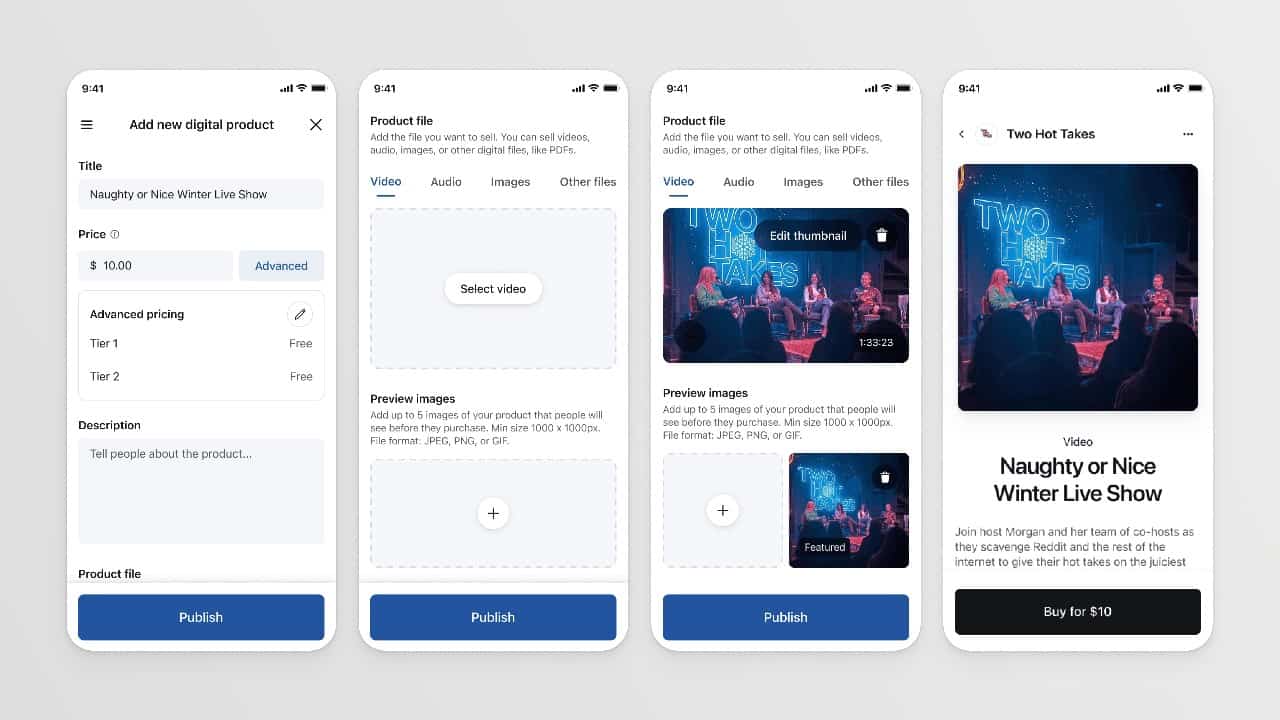
You’ve done the research, and at this stage, we’re assuming that you’ve built your product. Now it’s time to get it up on Patreon. Here’s how:
- Start by hitting the Shop tab on your creator profile.
- Hit the + New Product button.
- Give your product a name, a price, and a description.
- Hit the Membership pricing button if you want to give some of your patrons free access to your product.
- Choose your product type.
- Upload your product file.
- Upload preview images of your product.
- Hit Publish.
And that’s it — your digital product is live on Patreon! Now, it’s time to get people to buy it.
Step 5: Announce your new product on Patreon
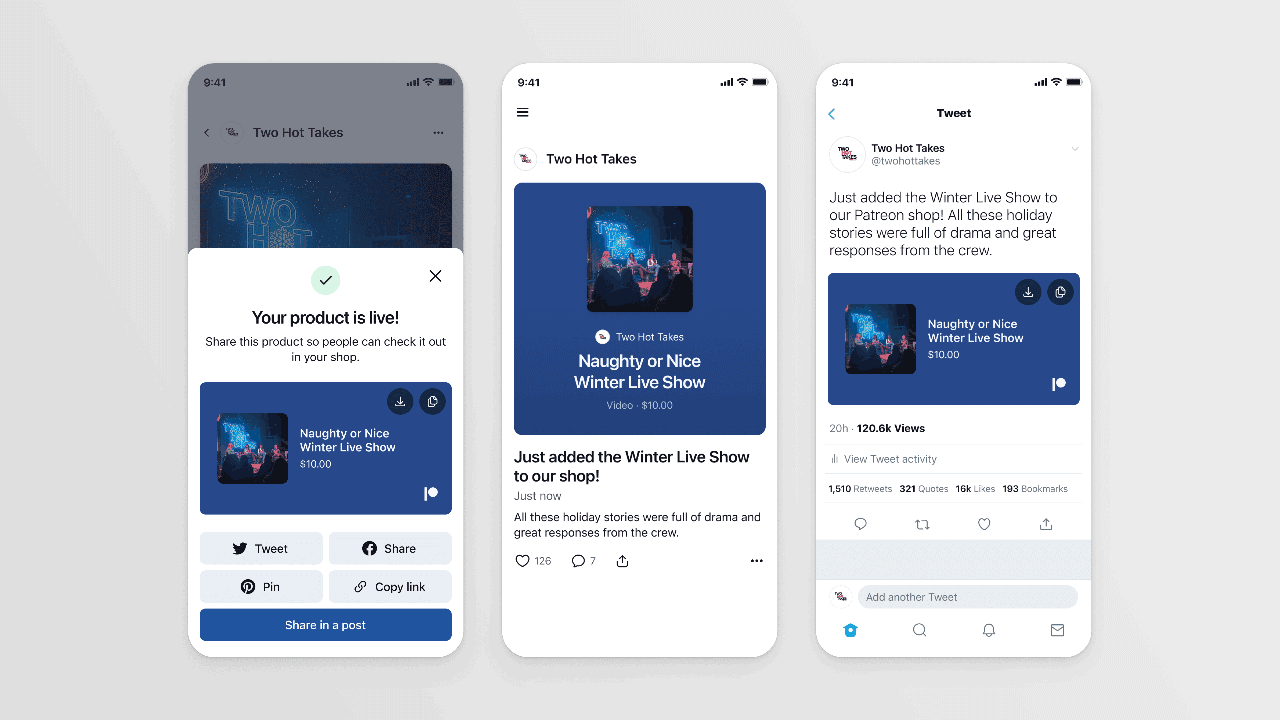
Patreon lets you embed any digital product into a Patreon post, meaning that you can promote it directly to your patrons instead of having to fight the algorithms on other platforms. And since your patrons already support your content directly, they’re more likely to buy your product than a YouTube subscriber or TikTok follower who watches your videos every once in a while.
Here are a few ideas on what to post on Patreon when promoting your digital product:
- Sneak peeks: You don’t have to wait until your digital product launches to promote it! Give your audience sneak peeks at a new product you’re working on. Showing the product creation process regularly to your patrons can help build hype for your launch.
- Countdowns: If you really want to generate buzz, try counting down to your product launch. Have each post tease a different part of the product, or explain why you think it’s the perfect product for your audience.
- Official launch: To drum up interest, you should make an announcement on Patreon the minute your product launches. Give your audience a breakdown of what they can expect and think of ways you can really pique their interest.
Step 6: Promote your product using other channels

Remember that digital products you sell on Patreon aren’t just for your patrons! Anyone can buy your digital product on your Patreon shop, even if they haven’t signed up for one of your membership tiers. That means you can promote your product through your other channels — like YouTube, TikTok, Instagram, or Substack — so your audience knows you’ve created a product for them.
Ready to sell your own digital products?
Selling digital products is one of the best ways to diversify your income as a content creator, and Patreon’s newest Commerce feature helps you do exactly that. While you’ll likely have to sit on the waitlist for a bit before you can set up your Patreon shop, once you’re in, you can easily start selling and promoting your digital products on the platform.
Want to create and sell your own digital products? Get our free Digital Product Launch Checklist to make your first product launch a seamless launch.
FAQ
How much does it cost to sell digital products on Patreon?
Patreon doesn’t charge you any money upfront for uploading digital products to your Patreon shop. Instead, it takes a cut of your sales, including the following fees:
- A 5% platform fee, taken from every successful sale.
- A variable payment processing fee, taken from every sale, depending on the currency you’re using.
- Currency conversion fees, for sales made in a currency other than your own.
- A payout fee, charged every time you move money from Patreon to your bank account.
When can I receive payouts from my digital product sales on Patreon?
You can receive funds from the sale of your digital products as soon as seven days after the sale is made. There are two ways you can receive payouts from your digital product sales on Patreon:
- Manually: You can manually withdraw funds after each sale if you’d like! You’ll just have to wait seven days from the time of the sale for those funds to be available.
- Automatically: You can also enable automatic payouts, and you’ll receive a payment on the 5th of every month covering the proceeds of sales made in that month.
Are my patrons the only people who can buy my digital products on Patreon?
Not at all! While patrons are probably more likely to shop from your Patreon, since they are already familiar with the platform, you can sell your digital products to anyone. That means you can add a link to your Patreon shop in your social media bio, and anyone who follows that link can buy what you have to offer.
Follow The Leap on TikTok, Instagram, and YouTube for more monetization tips for creators. We also make a newsletter.

